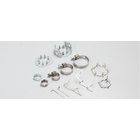Product Services
Featured product
Products/Services
-

Precision cold forging(9)
This is a processing method that involves applying force to metal at room temperature to deform it and create various shapes. Forging includes "hot forging" and "warm forging," where the metal material is heated before applying force, and "cold forging," where force is applied at room temperature. Hot forging results in significant dimensional changes and a rough surface, necessitating surface treatment in subsequent processes. In contrast, cold forging achieves precise shapes and has the advantage of not requiring surface finishing. Particularly when compared to cutting processes, cold forging deforms the material using molds, which eliminates cutting scrap and is expected to reduce costs and environmental impact, making it the greatest benefit. On the other hand, depending on the structure and shape of the mold, controlling excess material and deficiencies can be challenging. Our company specializes in obtaining long, thin hole shapes. (We can achieve inner diameters of around 20 mm and lengths of approximately 55 mm.) We also accommodate special materials that require hardness and are difficult to process, such as stainless steel, ferritic, and martensitic materials. Additionally, we handle aluminum materials used in fuel pumps and other applications.
-

Squeezing processing(9)
This is a processing method that stretches a thin metal plate into a cylindrical shape. Compared to cutting processes, it eliminates material waste and reduces costs. Additionally, since there are no leftover chips or debris, there is the advantage of fewer defective products. We manufacture parts such as automotive injectors, fuel pumps, EGRs, and throttles, achieving a high precision with an inner diameter tolerance of 0.03 to 0.05 millimeters.
-

Layered processing(7)
The electromagnetic steel sheets used for winding coils were traditionally processed by sintering iron and then machining. This process, known as laminated processing, involves stacking thin metal sheets and forming them through clinching in a progressive die. By eliminating machining, costs were reduced by 40%.
-

Rough machining(8)
This is a method for changing the thickness of a part that has been press-formed. By achieving different wall thicknesses through integrated molding instead of traditional cutting processes, we have successfully reduced costs. It is used in applications such as sealing plates for mobile lithium batteries and solenoid parts for transmissions.
-

Applied technology(7)
About applied technology

![Precision Cold Forging [Cold Forging of Difficult-to-Process Material SUS440C]](https://image.mono.ipros.com/public/product/image/6ce/2001536407/IPROS18267525774257643632.png?w=280&h=280)
![Precision cold forging [Deburring of holes in fuel injector components]](https://image.mono.ipros.com/public/product/image/beb/2001536406/IPROS1994628611553875312.png?w=280&h=280)